Quality Management in Business: A Report on Starbucks' Practices
VerifiedAdded on 2020/01/16
|10
|3309
|308
Report
AI Summary
This report provides a comprehensive analysis of quality management principles and their application within the context of Starbucks. It begins with a definition of quality in business and services, followed by an examination of Starbucks' quality assurance processes, including ISO standards and quality planning. The report then delves into various approaches to quality management, such as Total Quality Management (TQM), Six Sigma, and benchmarking, highlighting their similarities and differences in the Starbucks context. Customer satisfaction is explored, along with continuous improvement strategies and the added values gained through efficient operations. The report also addresses the types of information available to customers and the significance of effective marketing. Furthermore, it discusses quality measurement methods employed by Starbucks, including the use of surveys and complaint procedures. The report concludes with a summary of the findings and recommendations for enhancing quality management practices within Starbucks. The report is drawn in context to Starbucks a leading coffee branding in the international markets.
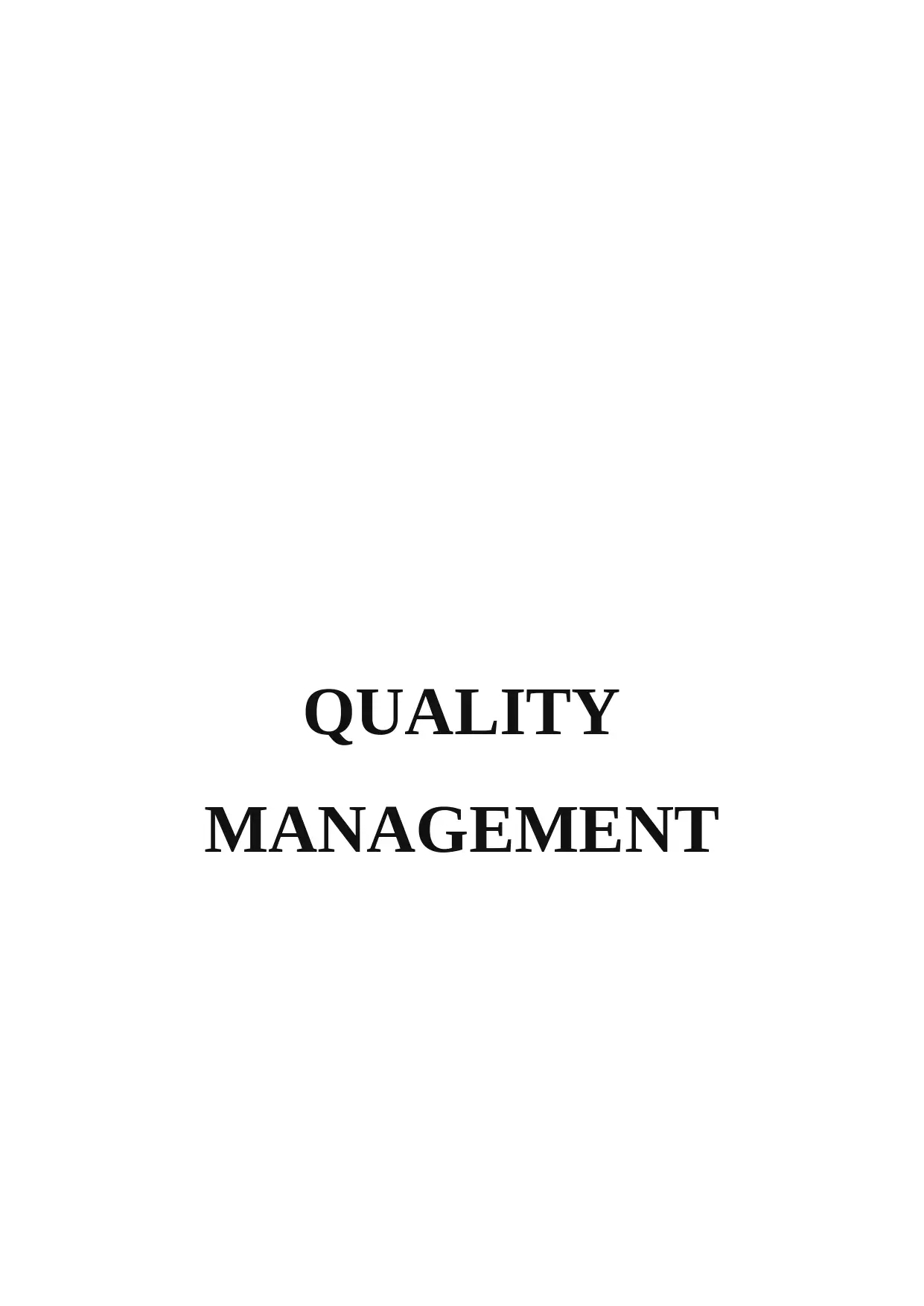
QUALITY
MANAGEMENT
MANAGEMENT
Paraphrase This Document
Need a fresh take? Get an instant paraphrase of this document with our AI Paraphraser
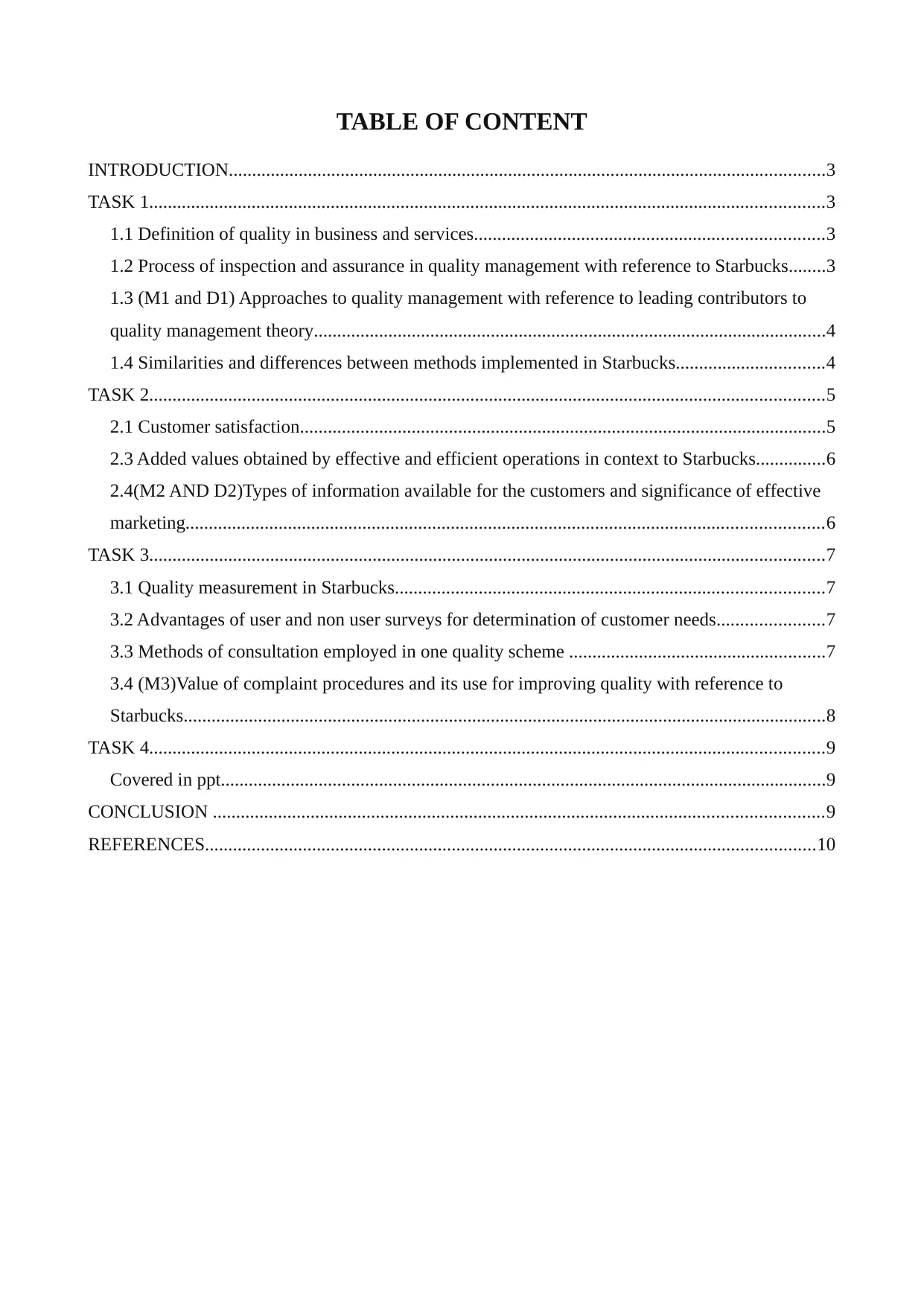
TABLE OF CONTENT
INTRODUCTION................................................................................................................................3
TASK 1.................................................................................................................................................3
1.1 Definition of quality in business and services...........................................................................3
1.2 Process of inspection and assurance in quality management with reference to Starbucks........3
1.3 (M1 and D1) Approaches to quality management with reference to leading contributors to
quality management theory..............................................................................................................4
1.4 Similarities and differences between methods implemented in Starbucks................................4
TASK 2.................................................................................................................................................5
2.1 Customer satisfaction.................................................................................................................5
2.3 Added values obtained by effective and efficient operations in context to Starbucks...............6
2.4(M2 AND D2)Types of information available for the customers and significance of effective
marketing.........................................................................................................................................6
TASK 3.................................................................................................................................................7
3.1 Quality measurement in Starbucks............................................................................................7
3.2 Advantages of user and non user surveys for determination of customer needs.......................7
3.3 Methods of consultation employed in one quality scheme .......................................................7
3.4 (M3)Value of complaint procedures and its use for improving quality with reference to
Starbucks..........................................................................................................................................8
TASK 4.................................................................................................................................................9
Covered in ppt..................................................................................................................................9
CONCLUSION ...................................................................................................................................9
REFERENCES...................................................................................................................................10
INTRODUCTION................................................................................................................................3
TASK 1.................................................................................................................................................3
1.1 Definition of quality in business and services...........................................................................3
1.2 Process of inspection and assurance in quality management with reference to Starbucks........3
1.3 (M1 and D1) Approaches to quality management with reference to leading contributors to
quality management theory..............................................................................................................4
1.4 Similarities and differences between methods implemented in Starbucks................................4
TASK 2.................................................................................................................................................5
2.1 Customer satisfaction.................................................................................................................5
2.3 Added values obtained by effective and efficient operations in context to Starbucks...............6
2.4(M2 AND D2)Types of information available for the customers and significance of effective
marketing.........................................................................................................................................6
TASK 3.................................................................................................................................................7
3.1 Quality measurement in Starbucks............................................................................................7
3.2 Advantages of user and non user surveys for determination of customer needs.......................7
3.3 Methods of consultation employed in one quality scheme .......................................................7
3.4 (M3)Value of complaint procedures and its use for improving quality with reference to
Starbucks..........................................................................................................................................8
TASK 4.................................................................................................................................................9
Covered in ppt..................................................................................................................................9
CONCLUSION ...................................................................................................................................9
REFERENCES...................................................................................................................................10
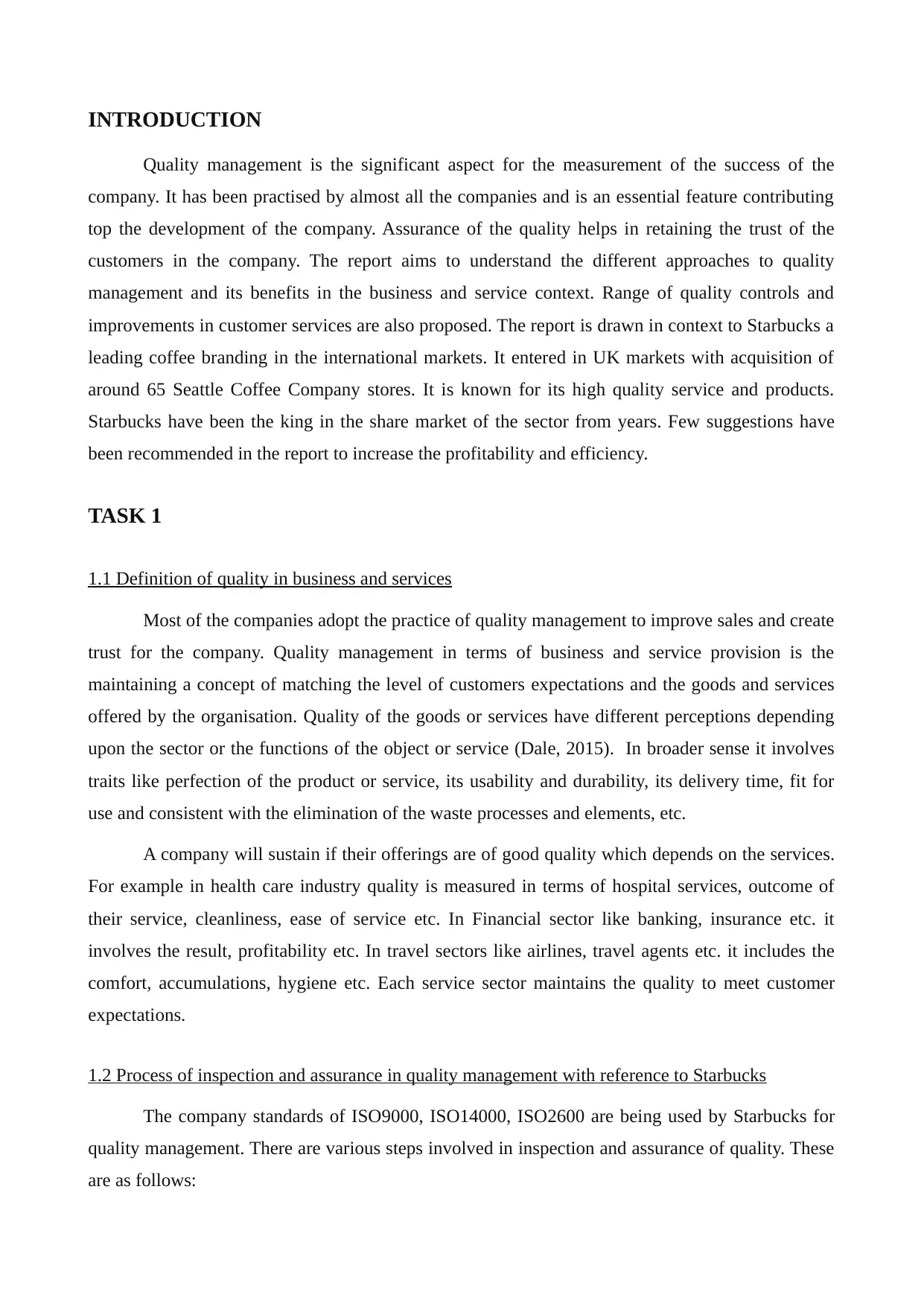
INTRODUCTION
Quality management is the significant aspect for the measurement of the success of the
company. It has been practised by almost all the companies and is an essential feature contributing
top the development of the company. Assurance of the quality helps in retaining the trust of the
customers in the company. The report aims to understand the different approaches to quality
management and its benefits in the business and service context. Range of quality controls and
improvements in customer services are also proposed. The report is drawn in context to Starbucks a
leading coffee branding in the international markets. It entered in UK markets with acquisition of
around 65 Seattle Coffee Company stores. It is known for its high quality service and products.
Starbucks have been the king in the share market of the sector from years. Few suggestions have
been recommended in the report to increase the profitability and efficiency.
TASK 1
1.1 Definition of quality in business and services
Most of the companies adopt the practice of quality management to improve sales and create
trust for the company. Quality management in terms of business and service provision is the
maintaining a concept of matching the level of customers expectations and the goods and services
offered by the organisation. Quality of the goods or services have different perceptions depending
upon the sector or the functions of the object or service (Dale, 2015). In broader sense it involves
traits like perfection of the product or service, its usability and durability, its delivery time, fit for
use and consistent with the elimination of the waste processes and elements, etc.
A company will sustain if their offerings are of good quality which depends on the services.
For example in health care industry quality is measured in terms of hospital services, outcome of
their service, cleanliness, ease of service etc. In Financial sector like banking, insurance etc. it
involves the result, profitability etc. In travel sectors like airlines, travel agents etc. it includes the
comfort, accumulations, hygiene etc. Each service sector maintains the quality to meet customer
expectations.
1.2 Process of inspection and assurance in quality management with reference to Starbucks
The company standards of ISO9000, ISO14000, ISO2600 are being used by Starbucks for
quality management. There are various steps involved in inspection and assurance of quality. These
are as follows:
Quality management is the significant aspect for the measurement of the success of the
company. It has been practised by almost all the companies and is an essential feature contributing
top the development of the company. Assurance of the quality helps in retaining the trust of the
customers in the company. The report aims to understand the different approaches to quality
management and its benefits in the business and service context. Range of quality controls and
improvements in customer services are also proposed. The report is drawn in context to Starbucks a
leading coffee branding in the international markets. It entered in UK markets with acquisition of
around 65 Seattle Coffee Company stores. It is known for its high quality service and products.
Starbucks have been the king in the share market of the sector from years. Few suggestions have
been recommended in the report to increase the profitability and efficiency.
TASK 1
1.1 Definition of quality in business and services
Most of the companies adopt the practice of quality management to improve sales and create
trust for the company. Quality management in terms of business and service provision is the
maintaining a concept of matching the level of customers expectations and the goods and services
offered by the organisation. Quality of the goods or services have different perceptions depending
upon the sector or the functions of the object or service (Dale, 2015). In broader sense it involves
traits like perfection of the product or service, its usability and durability, its delivery time, fit for
use and consistent with the elimination of the waste processes and elements, etc.
A company will sustain if their offerings are of good quality which depends on the services.
For example in health care industry quality is measured in terms of hospital services, outcome of
their service, cleanliness, ease of service etc. In Financial sector like banking, insurance etc. it
involves the result, profitability etc. In travel sectors like airlines, travel agents etc. it includes the
comfort, accumulations, hygiene etc. Each service sector maintains the quality to meet customer
expectations.
1.2 Process of inspection and assurance in quality management with reference to Starbucks
The company standards of ISO9000, ISO14000, ISO2600 are being used by Starbucks for
quality management. There are various steps involved in inspection and assurance of quality. These
are as follows:
⊘ This is a preview!⊘
Do you want full access?
Subscribe today to unlock all pages.

Trusted by 1+ million students worldwide
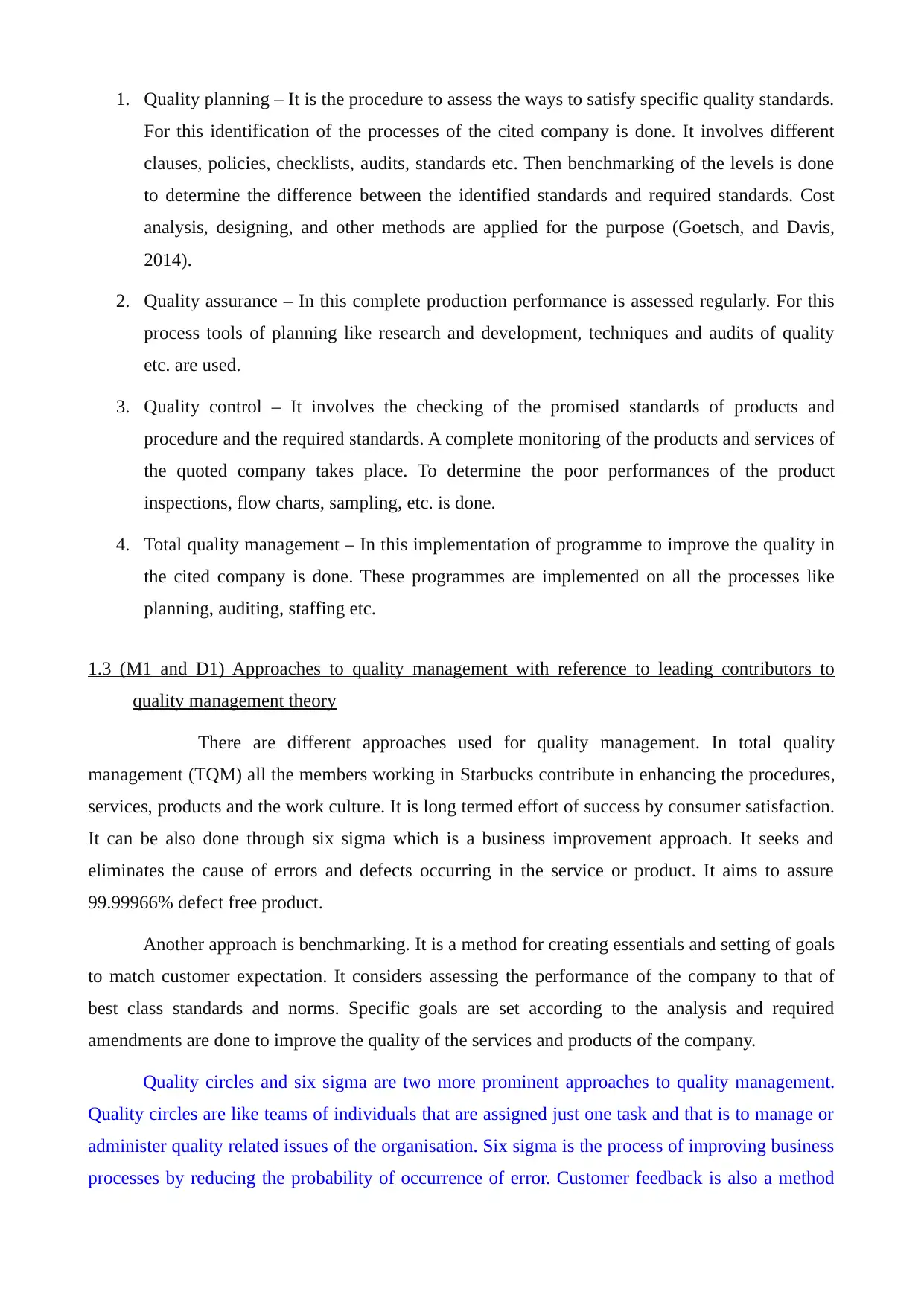
1. Quality planning – It is the procedure to assess the ways to satisfy specific quality standards.
For this identification of the processes of the cited company is done. It involves different
clauses, policies, checklists, audits, standards etc. Then benchmarking of the levels is done
to determine the difference between the identified standards and required standards. Cost
analysis, designing, and other methods are applied for the purpose (Goetsch, and Davis,
2014).
2. Quality assurance – In this complete production performance is assessed regularly. For this
process tools of planning like research and development, techniques and audits of quality
etc. are used.
3. Quality control – It involves the checking of the promised standards of products and
procedure and the required standards. A complete monitoring of the products and services of
the quoted company takes place. To determine the poor performances of the product
inspections, flow charts, sampling, etc. is done.
4. Total quality management – In this implementation of programme to improve the quality in
the cited company is done. These programmes are implemented on all the processes like
planning, auditing, staffing etc.
1.3 (M1 and D1) Approaches to quality management with reference to leading contributors to
quality management theory
There are different approaches used for quality management. In total quality
management (TQM) all the members working in Starbucks contribute in enhancing the procedures,
services, products and the work culture. It is long termed effort of success by consumer satisfaction.
It can be also done through six sigma which is a business improvement approach. It seeks and
eliminates the cause of errors and defects occurring in the service or product. It aims to assure
99.99966% defect free product.
Another approach is benchmarking. It is a method for creating essentials and setting of goals
to match customer expectation. It considers assessing the performance of the company to that of
best class standards and norms. Specific goals are set according to the analysis and required
amendments are done to improve the quality of the services and products of the company.
Quality circles and six sigma are two more prominent approaches to quality management.
Quality circles are like teams of individuals that are assigned just one task and that is to manage or
administer quality related issues of the organisation. Six sigma is the process of improving business
processes by reducing the probability of occurrence of error. Customer feedback is also a method
For this identification of the processes of the cited company is done. It involves different
clauses, policies, checklists, audits, standards etc. Then benchmarking of the levels is done
to determine the difference between the identified standards and required standards. Cost
analysis, designing, and other methods are applied for the purpose (Goetsch, and Davis,
2014).
2. Quality assurance – In this complete production performance is assessed regularly. For this
process tools of planning like research and development, techniques and audits of quality
etc. are used.
3. Quality control – It involves the checking of the promised standards of products and
procedure and the required standards. A complete monitoring of the products and services of
the quoted company takes place. To determine the poor performances of the product
inspections, flow charts, sampling, etc. is done.
4. Total quality management – In this implementation of programme to improve the quality in
the cited company is done. These programmes are implemented on all the processes like
planning, auditing, staffing etc.
1.3 (M1 and D1) Approaches to quality management with reference to leading contributors to
quality management theory
There are different approaches used for quality management. In total quality
management (TQM) all the members working in Starbucks contribute in enhancing the procedures,
services, products and the work culture. It is long termed effort of success by consumer satisfaction.
It can be also done through six sigma which is a business improvement approach. It seeks and
eliminates the cause of errors and defects occurring in the service or product. It aims to assure
99.99966% defect free product.
Another approach is benchmarking. It is a method for creating essentials and setting of goals
to match customer expectation. It considers assessing the performance of the company to that of
best class standards and norms. Specific goals are set according to the analysis and required
amendments are done to improve the quality of the services and products of the company.
Quality circles and six sigma are two more prominent approaches to quality management.
Quality circles are like teams of individuals that are assigned just one task and that is to manage or
administer quality related issues of the organisation. Six sigma is the process of improving business
processes by reducing the probability of occurrence of error. Customer feedback is also a method
Paraphrase This Document
Need a fresh take? Get an instant paraphrase of this document with our AI Paraphraser
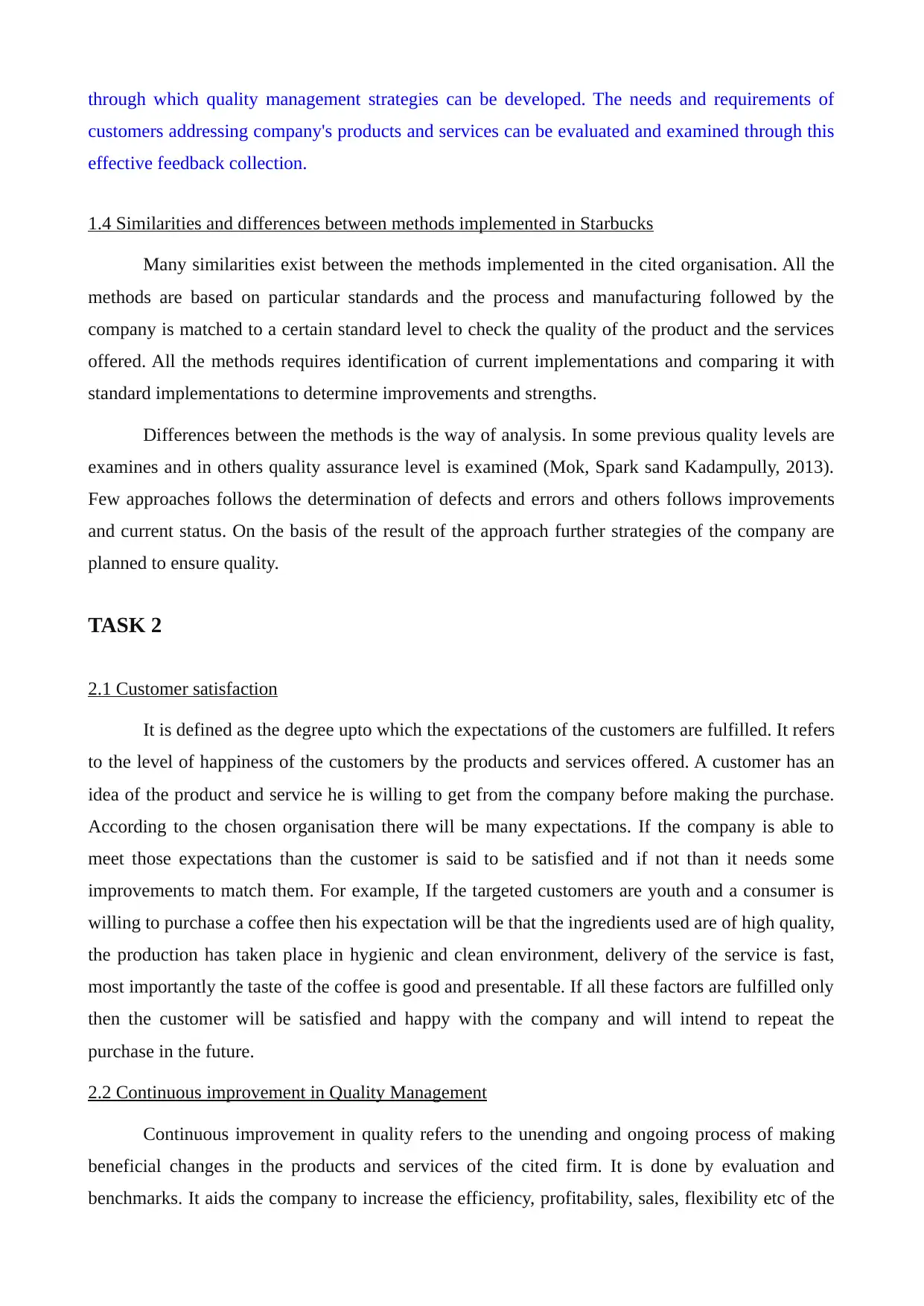
through which quality management strategies can be developed. The needs and requirements of
customers addressing company's products and services can be evaluated and examined through this
effective feedback collection.
1.4 Similarities and differences between methods implemented in Starbucks
Many similarities exist between the methods implemented in the cited organisation. All the
methods are based on particular standards and the process and manufacturing followed by the
company is matched to a certain standard level to check the quality of the product and the services
offered. All the methods requires identification of current implementations and comparing it with
standard implementations to determine improvements and strengths.
Differences between the methods is the way of analysis. In some previous quality levels are
examines and in others quality assurance level is examined (Mok, Spark sand Kadampully, 2013).
Few approaches follows the determination of defects and errors and others follows improvements
and current status. On the basis of the result of the approach further strategies of the company are
planned to ensure quality.
TASK 2
2.1 Customer satisfaction
It is defined as the degree upto which the expectations of the customers are fulfilled. It refers
to the level of happiness of the customers by the products and services offered. A customer has an
idea of the product and service he is willing to get from the company before making the purchase.
According to the chosen organisation there will be many expectations. If the company is able to
meet those expectations than the customer is said to be satisfied and if not than it needs some
improvements to match them. For example, If the targeted customers are youth and a consumer is
willing to purchase a coffee then his expectation will be that the ingredients used are of high quality,
the production has taken place in hygienic and clean environment, delivery of the service is fast,
most importantly the taste of the coffee is good and presentable. If all these factors are fulfilled only
then the customer will be satisfied and happy with the company and will intend to repeat the
purchase in the future.
2.2 Continuous improvement in Quality Management
Continuous improvement in quality refers to the unending and ongoing process of making
beneficial changes in the products and services of the cited firm. It is done by evaluation and
benchmarks. It aids the company to increase the efficiency, profitability, sales, flexibility etc of the
customers addressing company's products and services can be evaluated and examined through this
effective feedback collection.
1.4 Similarities and differences between methods implemented in Starbucks
Many similarities exist between the methods implemented in the cited organisation. All the
methods are based on particular standards and the process and manufacturing followed by the
company is matched to a certain standard level to check the quality of the product and the services
offered. All the methods requires identification of current implementations and comparing it with
standard implementations to determine improvements and strengths.
Differences between the methods is the way of analysis. In some previous quality levels are
examines and in others quality assurance level is examined (Mok, Spark sand Kadampully, 2013).
Few approaches follows the determination of defects and errors and others follows improvements
and current status. On the basis of the result of the approach further strategies of the company are
planned to ensure quality.
TASK 2
2.1 Customer satisfaction
It is defined as the degree upto which the expectations of the customers are fulfilled. It refers
to the level of happiness of the customers by the products and services offered. A customer has an
idea of the product and service he is willing to get from the company before making the purchase.
According to the chosen organisation there will be many expectations. If the company is able to
meet those expectations than the customer is said to be satisfied and if not than it needs some
improvements to match them. For example, If the targeted customers are youth and a consumer is
willing to purchase a coffee then his expectation will be that the ingredients used are of high quality,
the production has taken place in hygienic and clean environment, delivery of the service is fast,
most importantly the taste of the coffee is good and presentable. If all these factors are fulfilled only
then the customer will be satisfied and happy with the company and will intend to repeat the
purchase in the future.
2.2 Continuous improvement in Quality Management
Continuous improvement in quality refers to the unending and ongoing process of making
beneficial changes in the products and services of the cited firm. It is done by evaluation and
benchmarks. It aids the company to increase the efficiency, profitability, sales, flexibility etc of the
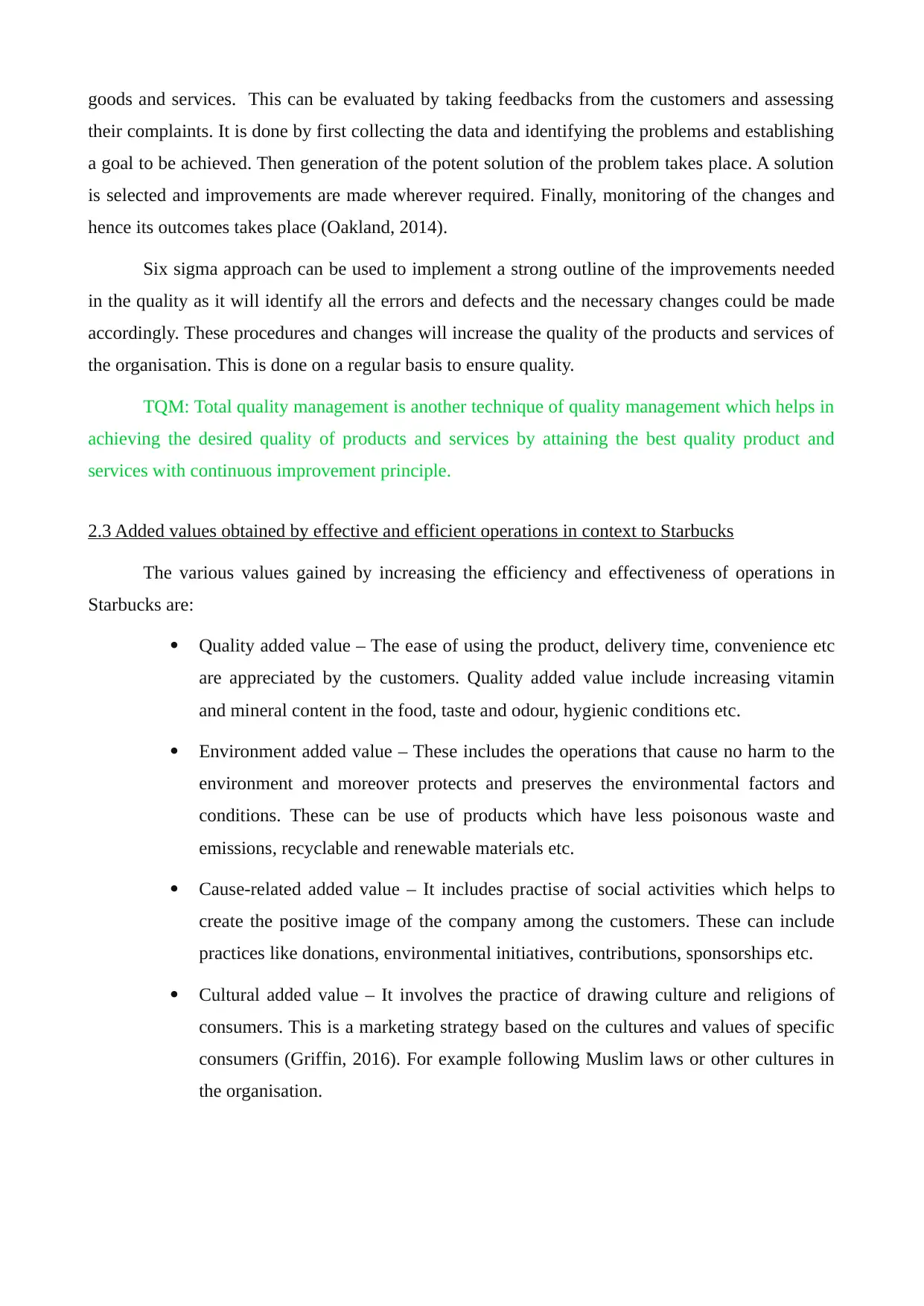
goods and services. This can be evaluated by taking feedbacks from the customers and assessing
their complaints. It is done by first collecting the data and identifying the problems and establishing
a goal to be achieved. Then generation of the potent solution of the problem takes place. A solution
is selected and improvements are made wherever required. Finally, monitoring of the changes and
hence its outcomes takes place (Oakland, 2014).
Six sigma approach can be used to implement a strong outline of the improvements needed
in the quality as it will identify all the errors and defects and the necessary changes could be made
accordingly. These procedures and changes will increase the quality of the products and services of
the organisation. This is done on a regular basis to ensure quality.
TQM: Total quality management is another technique of quality management which helps in
achieving the desired quality of products and services by attaining the best quality product and
services with continuous improvement principle.
2.3 Added values obtained by effective and efficient operations in context to Starbucks
The various values gained by increasing the efficiency and effectiveness of operations in
Starbucks are:
Quality added value – The ease of using the product, delivery time, convenience etc
are appreciated by the customers. Quality added value include increasing vitamin
and mineral content in the food, taste and odour, hygienic conditions etc.
Environment added value – These includes the operations that cause no harm to the
environment and moreover protects and preserves the environmental factors and
conditions. These can be use of products which have less poisonous waste and
emissions, recyclable and renewable materials etc.
Cause-related added value – It includes practise of social activities which helps to
create the positive image of the company among the customers. These can include
practices like donations, environmental initiatives, contributions, sponsorships etc.
Cultural added value – It involves the practice of drawing culture and religions of
consumers. This is a marketing strategy based on the cultures and values of specific
consumers (Griffin, 2016). For example following Muslim laws or other cultures in
the organisation.
their complaints. It is done by first collecting the data and identifying the problems and establishing
a goal to be achieved. Then generation of the potent solution of the problem takes place. A solution
is selected and improvements are made wherever required. Finally, monitoring of the changes and
hence its outcomes takes place (Oakland, 2014).
Six sigma approach can be used to implement a strong outline of the improvements needed
in the quality as it will identify all the errors and defects and the necessary changes could be made
accordingly. These procedures and changes will increase the quality of the products and services of
the organisation. This is done on a regular basis to ensure quality.
TQM: Total quality management is another technique of quality management which helps in
achieving the desired quality of products and services by attaining the best quality product and
services with continuous improvement principle.
2.3 Added values obtained by effective and efficient operations in context to Starbucks
The various values gained by increasing the efficiency and effectiveness of operations in
Starbucks are:
Quality added value – The ease of using the product, delivery time, convenience etc
are appreciated by the customers. Quality added value include increasing vitamin
and mineral content in the food, taste and odour, hygienic conditions etc.
Environment added value – These includes the operations that cause no harm to the
environment and moreover protects and preserves the environmental factors and
conditions. These can be use of products which have less poisonous waste and
emissions, recyclable and renewable materials etc.
Cause-related added value – It includes practise of social activities which helps to
create the positive image of the company among the customers. These can include
practices like donations, environmental initiatives, contributions, sponsorships etc.
Cultural added value – It involves the practice of drawing culture and religions of
consumers. This is a marketing strategy based on the cultures and values of specific
consumers (Griffin, 2016). For example following Muslim laws or other cultures in
the organisation.
⊘ This is a preview!⊘
Do you want full access?
Subscribe today to unlock all pages.

Trusted by 1+ million students worldwide
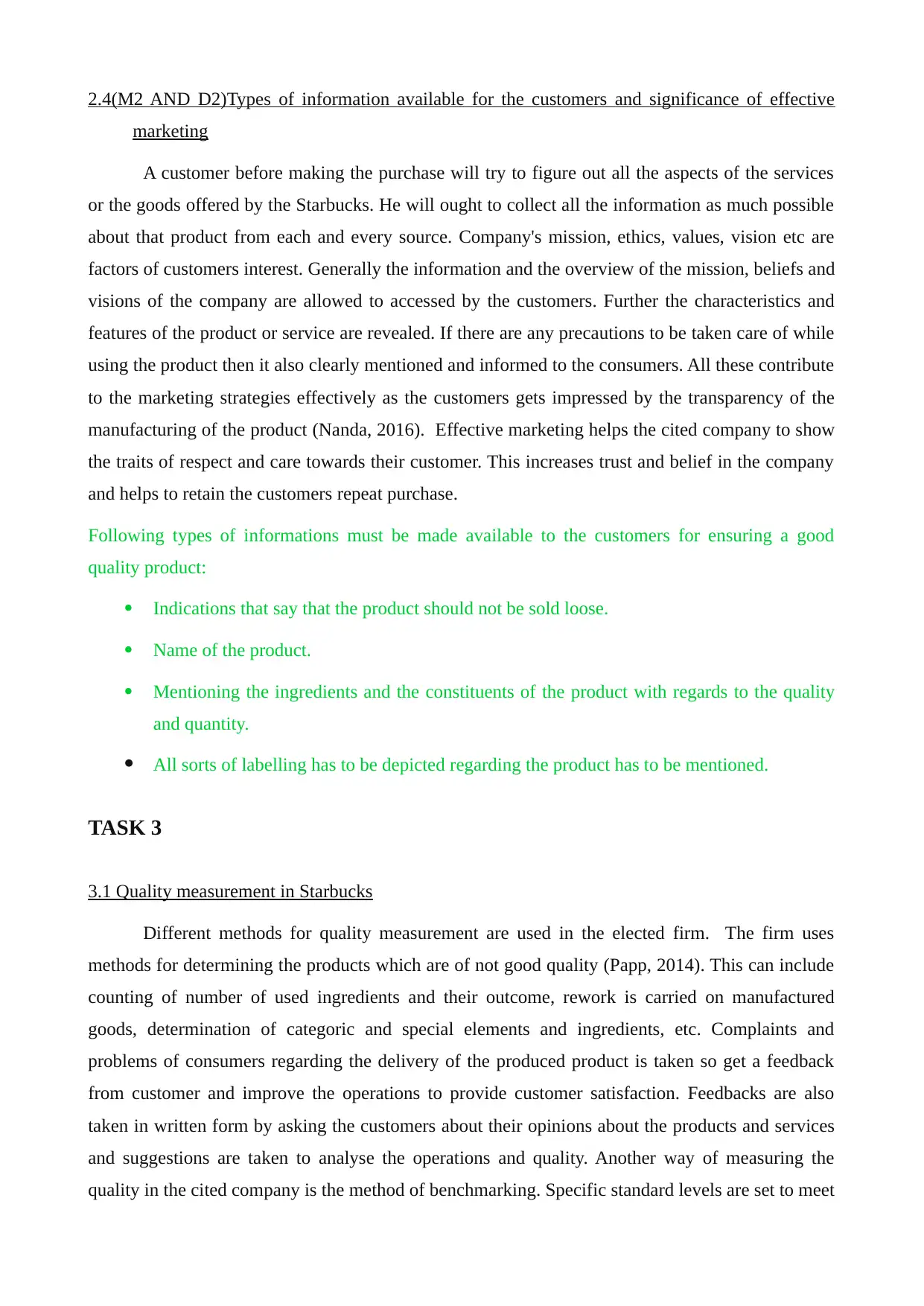
2.4(M2 AND D2)Types of information available for the customers and significance of effective
marketing
A customer before making the purchase will try to figure out all the aspects of the services
or the goods offered by the Starbucks. He will ought to collect all the information as much possible
about that product from each and every source. Company's mission, ethics, values, vision etc are
factors of customers interest. Generally the information and the overview of the mission, beliefs and
visions of the company are allowed to accessed by the customers. Further the characteristics and
features of the product or service are revealed. If there are any precautions to be taken care of while
using the product then it also clearly mentioned and informed to the consumers. All these contribute
to the marketing strategies effectively as the customers gets impressed by the transparency of the
manufacturing of the product (Nanda, 2016). Effective marketing helps the cited company to show
the traits of respect and care towards their customer. This increases trust and belief in the company
and helps to retain the customers repeat purchase.
Following types of informations must be made available to the customers for ensuring a good
quality product:
Indications that say that the product should not be sold loose.
Name of the product.
Mentioning the ingredients and the constituents of the product with regards to the quality
and quantity.
All sorts of labelling has to be depicted regarding the product has to be mentioned.
TASK 3
3.1 Quality measurement in Starbucks
Different methods for quality measurement are used in the elected firm. The firm uses
methods for determining the products which are of not good quality (Papp, 2014). This can include
counting of number of used ingredients and their outcome, rework is carried on manufactured
goods, determination of categoric and special elements and ingredients, etc. Complaints and
problems of consumers regarding the delivery of the produced product is taken so get a feedback
from customer and improve the operations to provide customer satisfaction. Feedbacks are also
taken in written form by asking the customers about their opinions about the products and services
and suggestions are taken to analyse the operations and quality. Another way of measuring the
quality in the cited company is the method of benchmarking. Specific standard levels are set to meet
marketing
A customer before making the purchase will try to figure out all the aspects of the services
or the goods offered by the Starbucks. He will ought to collect all the information as much possible
about that product from each and every source. Company's mission, ethics, values, vision etc are
factors of customers interest. Generally the information and the overview of the mission, beliefs and
visions of the company are allowed to accessed by the customers. Further the characteristics and
features of the product or service are revealed. If there are any precautions to be taken care of while
using the product then it also clearly mentioned and informed to the consumers. All these contribute
to the marketing strategies effectively as the customers gets impressed by the transparency of the
manufacturing of the product (Nanda, 2016). Effective marketing helps the cited company to show
the traits of respect and care towards their customer. This increases trust and belief in the company
and helps to retain the customers repeat purchase.
Following types of informations must be made available to the customers for ensuring a good
quality product:
Indications that say that the product should not be sold loose.
Name of the product.
Mentioning the ingredients and the constituents of the product with regards to the quality
and quantity.
All sorts of labelling has to be depicted regarding the product has to be mentioned.
TASK 3
3.1 Quality measurement in Starbucks
Different methods for quality measurement are used in the elected firm. The firm uses
methods for determining the products which are of not good quality (Papp, 2014). This can include
counting of number of used ingredients and their outcome, rework is carried on manufactured
goods, determination of categoric and special elements and ingredients, etc. Complaints and
problems of consumers regarding the delivery of the produced product is taken so get a feedback
from customer and improve the operations to provide customer satisfaction. Feedbacks are also
taken in written form by asking the customers about their opinions about the products and services
and suggestions are taken to analyse the operations and quality. Another way of measuring the
quality in the cited company is the method of benchmarking. Specific standard levels are set to meet
Paraphrase This Document
Need a fresh take? Get an instant paraphrase of this document with our AI Paraphraser
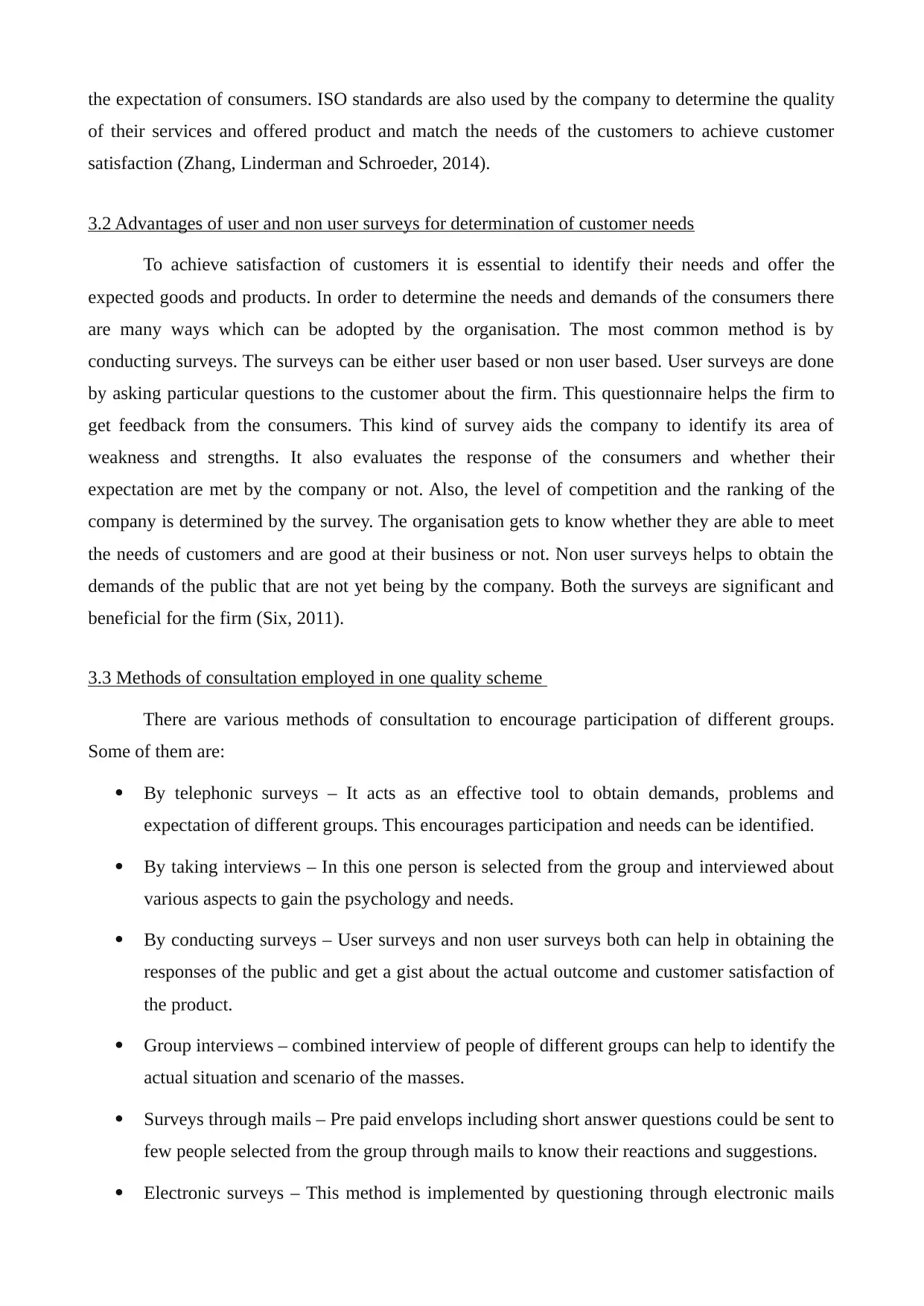
the expectation of consumers. ISO standards are also used by the company to determine the quality
of their services and offered product and match the needs of the customers to achieve customer
satisfaction (Zhang, Linderman and Schroeder, 2014).
3.2 Advantages of user and non user surveys for determination of customer needs
To achieve satisfaction of customers it is essential to identify their needs and offer the
expected goods and products. In order to determine the needs and demands of the consumers there
are many ways which can be adopted by the organisation. The most common method is by
conducting surveys. The surveys can be either user based or non user based. User surveys are done
by asking particular questions to the customer about the firm. This questionnaire helps the firm to
get feedback from the consumers. This kind of survey aids the company to identify its area of
weakness and strengths. It also evaluates the response of the consumers and whether their
expectation are met by the company or not. Also, the level of competition and the ranking of the
company is determined by the survey. The organisation gets to know whether they are able to meet
the needs of customers and are good at their business or not. Non user surveys helps to obtain the
demands of the public that are not yet being by the company. Both the surveys are significant and
beneficial for the firm (Six, 2011).
3.3 Methods of consultation employed in one quality scheme
There are various methods of consultation to encourage participation of different groups.
Some of them are:
By telephonic surveys – It acts as an effective tool to obtain demands, problems and
expectation of different groups. This encourages participation and needs can be identified.
By taking interviews – In this one person is selected from the group and interviewed about
various aspects to gain the psychology and needs.
By conducting surveys – User surveys and non user surveys both can help in obtaining the
responses of the public and get a gist about the actual outcome and customer satisfaction of
the product.
Group interviews – combined interview of people of different groups can help to identify the
actual situation and scenario of the masses.
Surveys through mails – Pre paid envelops including short answer questions could be sent to
few people selected from the group through mails to know their reactions and suggestions.
Electronic surveys – This method is implemented by questioning through electronic mails
of their services and offered product and match the needs of the customers to achieve customer
satisfaction (Zhang, Linderman and Schroeder, 2014).
3.2 Advantages of user and non user surveys for determination of customer needs
To achieve satisfaction of customers it is essential to identify their needs and offer the
expected goods and products. In order to determine the needs and demands of the consumers there
are many ways which can be adopted by the organisation. The most common method is by
conducting surveys. The surveys can be either user based or non user based. User surveys are done
by asking particular questions to the customer about the firm. This questionnaire helps the firm to
get feedback from the consumers. This kind of survey aids the company to identify its area of
weakness and strengths. It also evaluates the response of the consumers and whether their
expectation are met by the company or not. Also, the level of competition and the ranking of the
company is determined by the survey. The organisation gets to know whether they are able to meet
the needs of customers and are good at their business or not. Non user surveys helps to obtain the
demands of the public that are not yet being by the company. Both the surveys are significant and
beneficial for the firm (Six, 2011).
3.3 Methods of consultation employed in one quality scheme
There are various methods of consultation to encourage participation of different groups.
Some of them are:
By telephonic surveys – It acts as an effective tool to obtain demands, problems and
expectation of different groups. This encourages participation and needs can be identified.
By taking interviews – In this one person is selected from the group and interviewed about
various aspects to gain the psychology and needs.
By conducting surveys – User surveys and non user surveys both can help in obtaining the
responses of the public and get a gist about the actual outcome and customer satisfaction of
the product.
Group interviews – combined interview of people of different groups can help to identify the
actual situation and scenario of the masses.
Surveys through mails – Pre paid envelops including short answer questions could be sent to
few people selected from the group through mails to know their reactions and suggestions.
Electronic surveys – This method is implemented by questioning through electronic mails
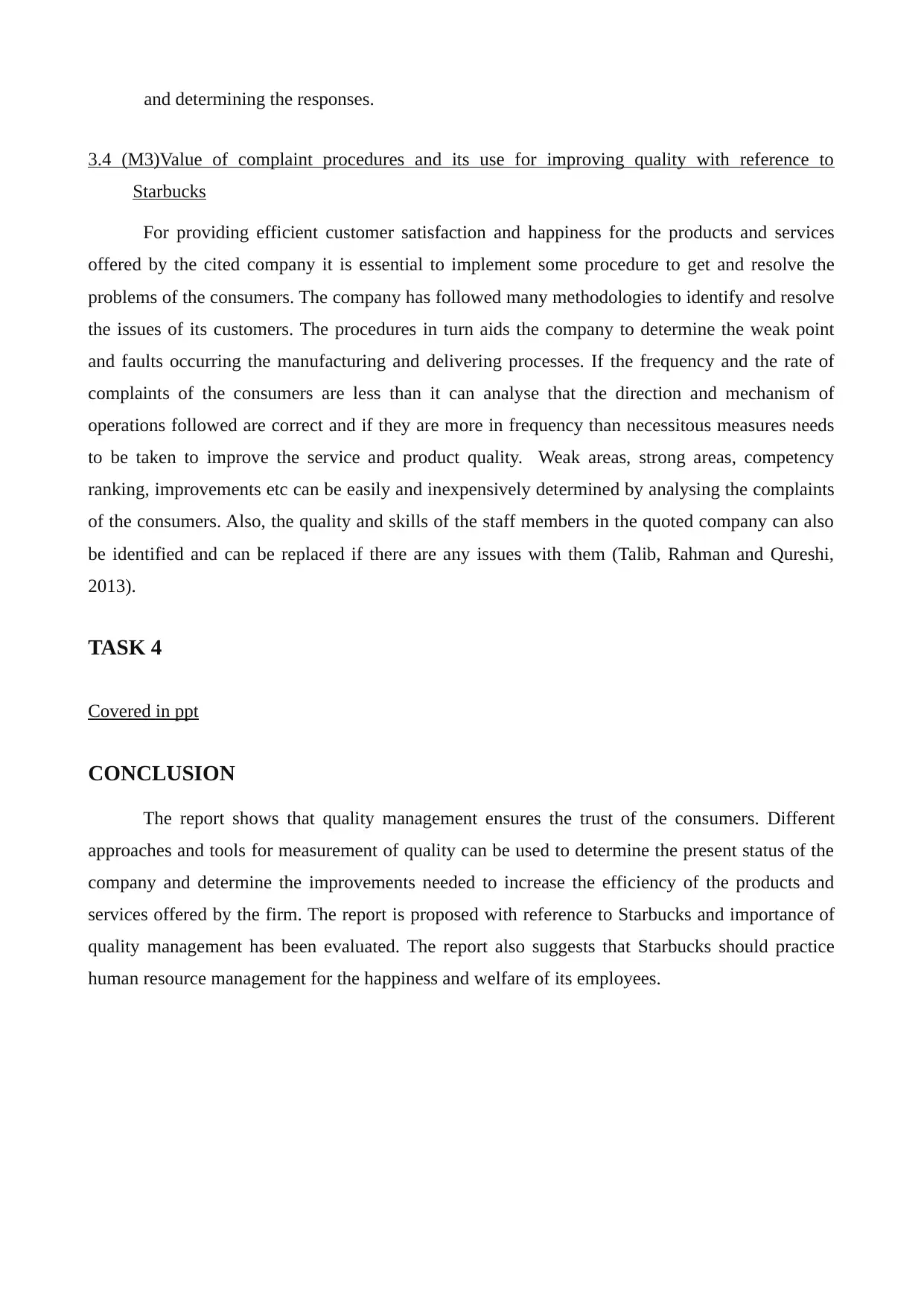
and determining the responses.
3.4 (M3)Value of complaint procedures and its use for improving quality with reference to
Starbucks
For providing efficient customer satisfaction and happiness for the products and services
offered by the cited company it is essential to implement some procedure to get and resolve the
problems of the consumers. The company has followed many methodologies to identify and resolve
the issues of its customers. The procedures in turn aids the company to determine the weak point
and faults occurring the manufacturing and delivering processes. If the frequency and the rate of
complaints of the consumers are less than it can analyse that the direction and mechanism of
operations followed are correct and if they are more in frequency than necessitous measures needs
to be taken to improve the service and product quality. Weak areas, strong areas, competency
ranking, improvements etc can be easily and inexpensively determined by analysing the complaints
of the consumers. Also, the quality and skills of the staff members in the quoted company can also
be identified and can be replaced if there are any issues with them (Talib, Rahman and Qureshi,
2013).
TASK 4
Covered in ppt
CONCLUSION
The report shows that quality management ensures the trust of the consumers. Different
approaches and tools for measurement of quality can be used to determine the present status of the
company and determine the improvements needed to increase the efficiency of the products and
services offered by the firm. The report is proposed with reference to Starbucks and importance of
quality management has been evaluated. The report also suggests that Starbucks should practice
human resource management for the happiness and welfare of its employees.
3.4 (M3)Value of complaint procedures and its use for improving quality with reference to
Starbucks
For providing efficient customer satisfaction and happiness for the products and services
offered by the cited company it is essential to implement some procedure to get and resolve the
problems of the consumers. The company has followed many methodologies to identify and resolve
the issues of its customers. The procedures in turn aids the company to determine the weak point
and faults occurring the manufacturing and delivering processes. If the frequency and the rate of
complaints of the consumers are less than it can analyse that the direction and mechanism of
operations followed are correct and if they are more in frequency than necessitous measures needs
to be taken to improve the service and product quality. Weak areas, strong areas, competency
ranking, improvements etc can be easily and inexpensively determined by analysing the complaints
of the consumers. Also, the quality and skills of the staff members in the quoted company can also
be identified and can be replaced if there are any issues with them (Talib, Rahman and Qureshi,
2013).
TASK 4
Covered in ppt
CONCLUSION
The report shows that quality management ensures the trust of the consumers. Different
approaches and tools for measurement of quality can be used to determine the present status of the
company and determine the improvements needed to increase the efficiency of the products and
services offered by the firm. The report is proposed with reference to Starbucks and importance of
quality management has been evaluated. The report also suggests that Starbucks should practice
human resource management for the happiness and welfare of its employees.
⊘ This is a preview!⊘
Do you want full access?
Subscribe today to unlock all pages.

Trusted by 1+ million students worldwide
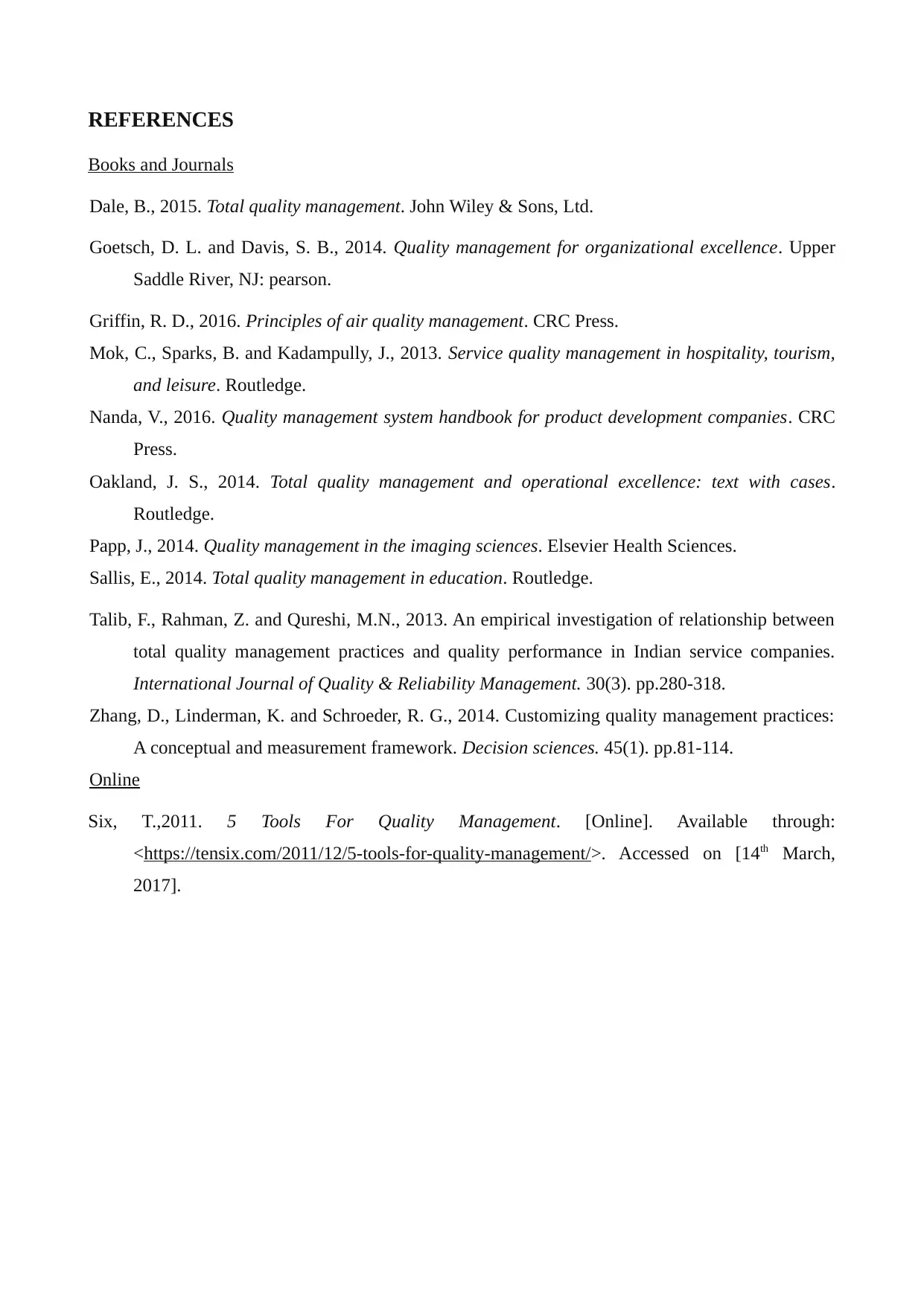
REFERENCES
Books and Journals
Dale, B., 2015. Total quality management. John Wiley & Sons, Ltd.
Goetsch, D. L. and Davis, S. B., 2014. Quality management for organizational excellence. Upper
Saddle River, NJ: pearson.
Griffin, R. D., 2016. Principles of air quality management. CRC Press.
Mok, C., Sparks, B. and Kadampully, J., 2013. Service quality management in hospitality, tourism,
and leisure. Routledge.
Nanda, V., 2016. Quality management system handbook for product development companies. CRC
Press.
Oakland, J. S., 2014. Total quality management and operational excellence: text with cases.
Routledge.
Papp, J., 2014. Quality management in the imaging sciences. Elsevier Health Sciences.
Sallis, E., 2014. Total quality management in education. Routledge.
Talib, F., Rahman, Z. and Qureshi, M.N., 2013. An empirical investigation of relationship between
total quality management practices and quality performance in Indian service companies.
International Journal of Quality & Reliability Management. 30(3). pp.280-318.
Zhang, D., Linderman, K. and Schroeder, R. G., 2014. Customizing quality management practices:
A conceptual and measurement framework. Decision sciences. 45(1). pp.81-114.
Online
Six, T.,2011. 5 Tools For Quality Management. [Online]. Available through:
<https://tensix.com/2011/12/5-tools-for-quality-management/>. Accessed on [14th March,
2017].
Books and Journals
Dale, B., 2015. Total quality management. John Wiley & Sons, Ltd.
Goetsch, D. L. and Davis, S. B., 2014. Quality management for organizational excellence. Upper
Saddle River, NJ: pearson.
Griffin, R. D., 2016. Principles of air quality management. CRC Press.
Mok, C., Sparks, B. and Kadampully, J., 2013. Service quality management in hospitality, tourism,
and leisure. Routledge.
Nanda, V., 2016. Quality management system handbook for product development companies. CRC
Press.
Oakland, J. S., 2014. Total quality management and operational excellence: text with cases.
Routledge.
Papp, J., 2014. Quality management in the imaging sciences. Elsevier Health Sciences.
Sallis, E., 2014. Total quality management in education. Routledge.
Talib, F., Rahman, Z. and Qureshi, M.N., 2013. An empirical investigation of relationship between
total quality management practices and quality performance in Indian service companies.
International Journal of Quality & Reliability Management. 30(3). pp.280-318.
Zhang, D., Linderman, K. and Schroeder, R. G., 2014. Customizing quality management practices:
A conceptual and measurement framework. Decision sciences. 45(1). pp.81-114.
Online
Six, T.,2011. 5 Tools For Quality Management. [Online]. Available through:
<https://tensix.com/2011/12/5-tools-for-quality-management/>. Accessed on [14th March,
2017].
1 out of 10
Related Documents
Your All-in-One AI-Powered Toolkit for Academic Success.
+13062052269
info@desklib.com
Available 24*7 on WhatsApp / Email
![[object Object]](/_next/static/media/star-bottom.7253800d.svg)
Unlock your academic potential
Copyright © 2020–2025 A2Z Services. All Rights Reserved. Developed and managed by ZUCOL.





